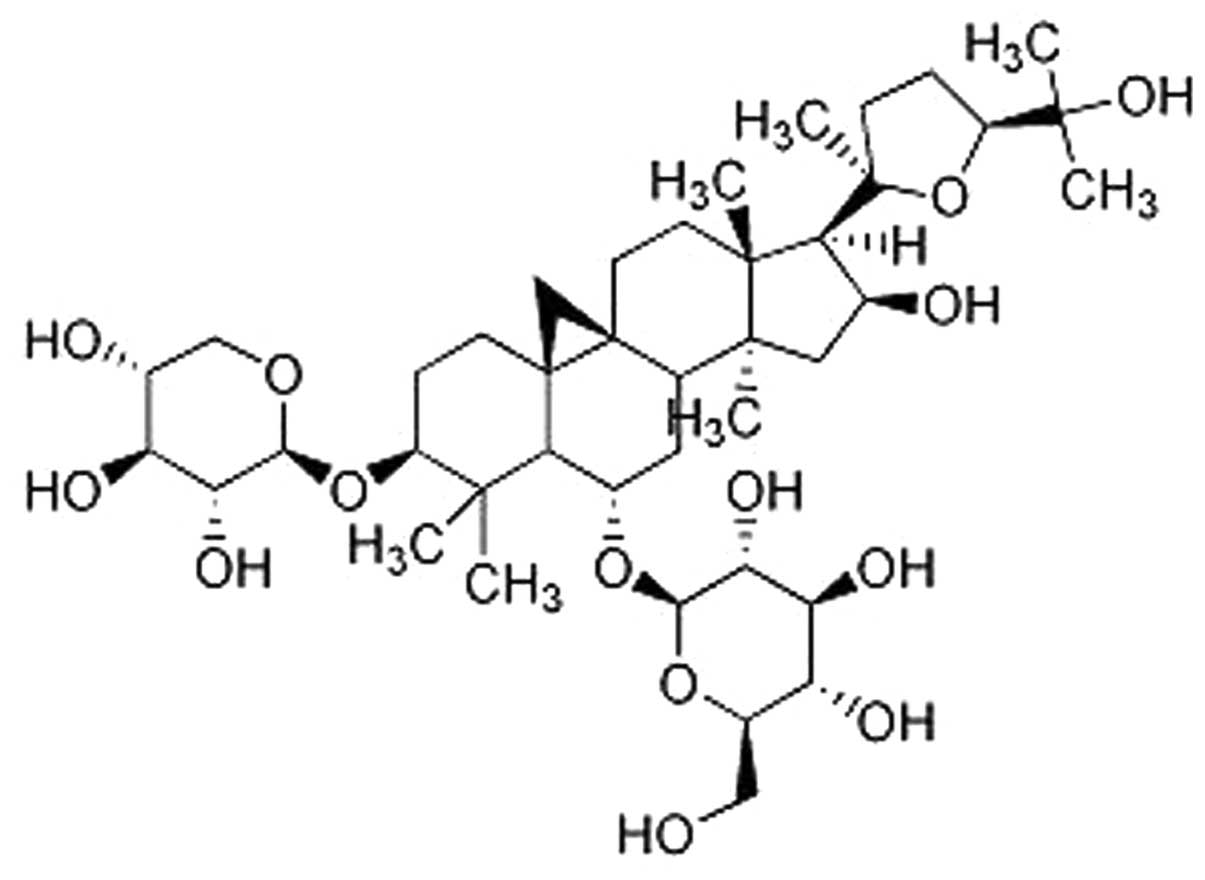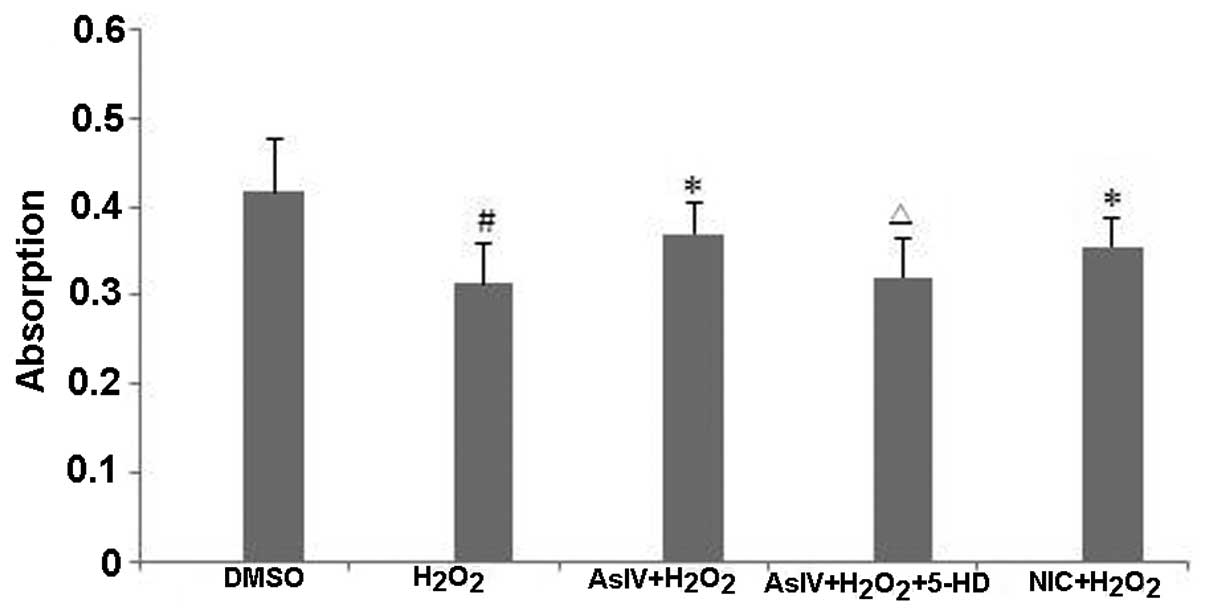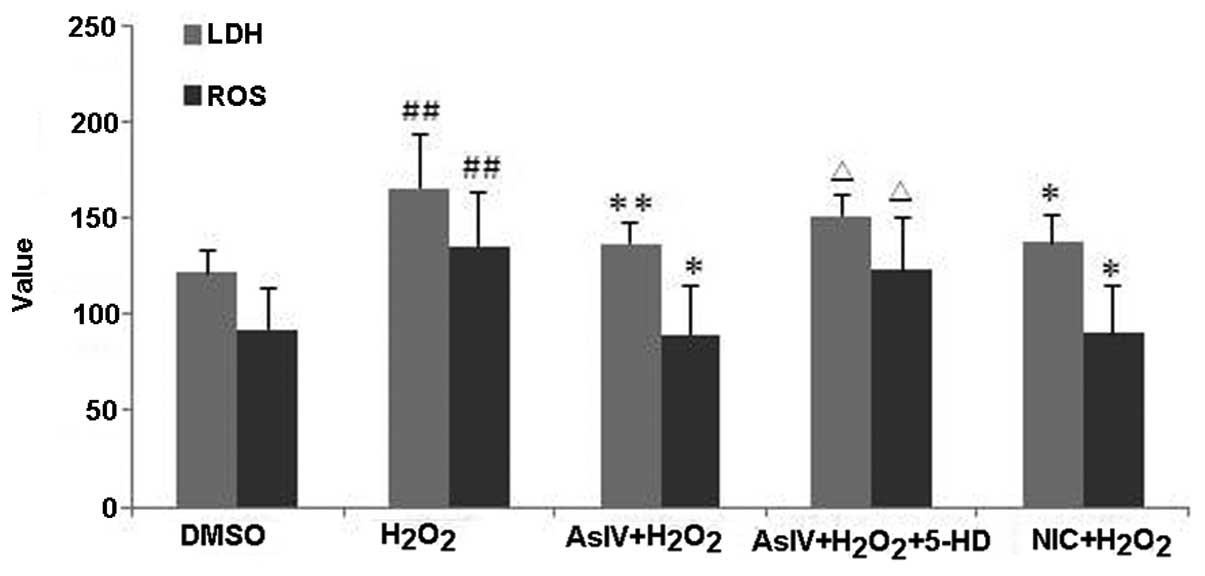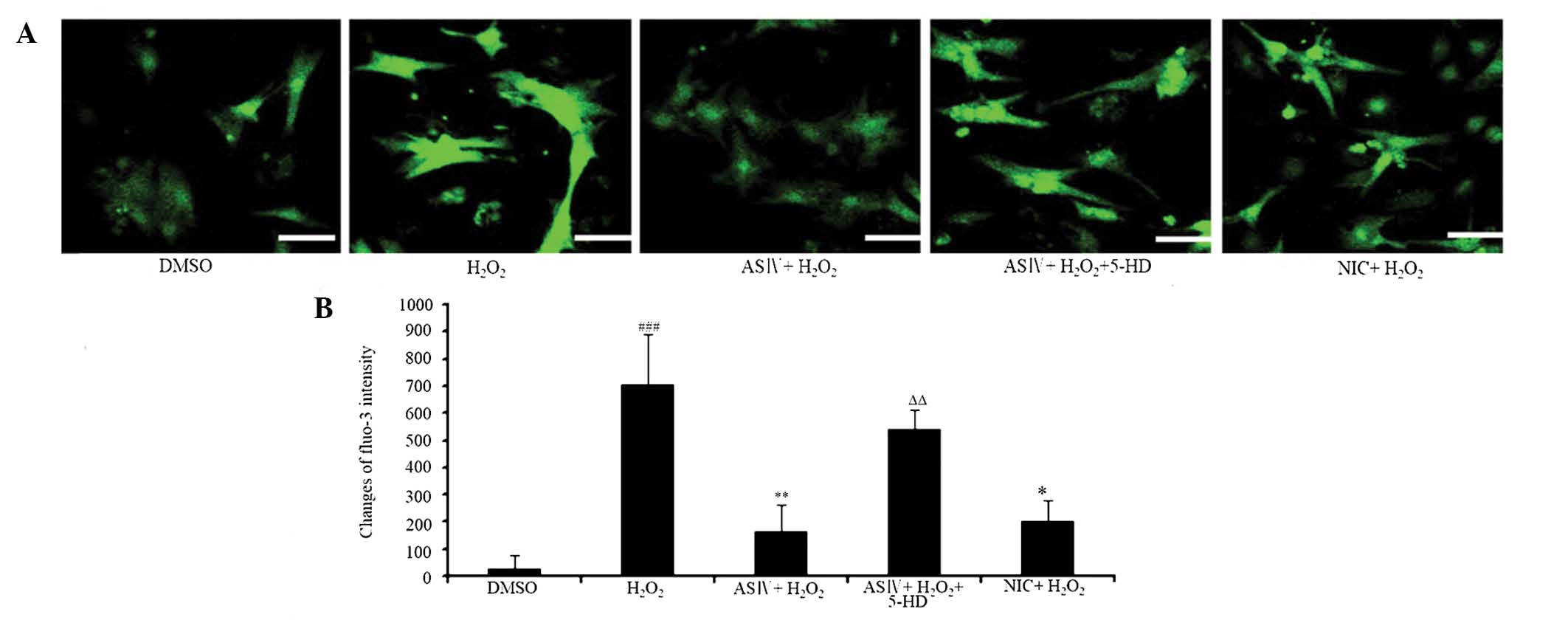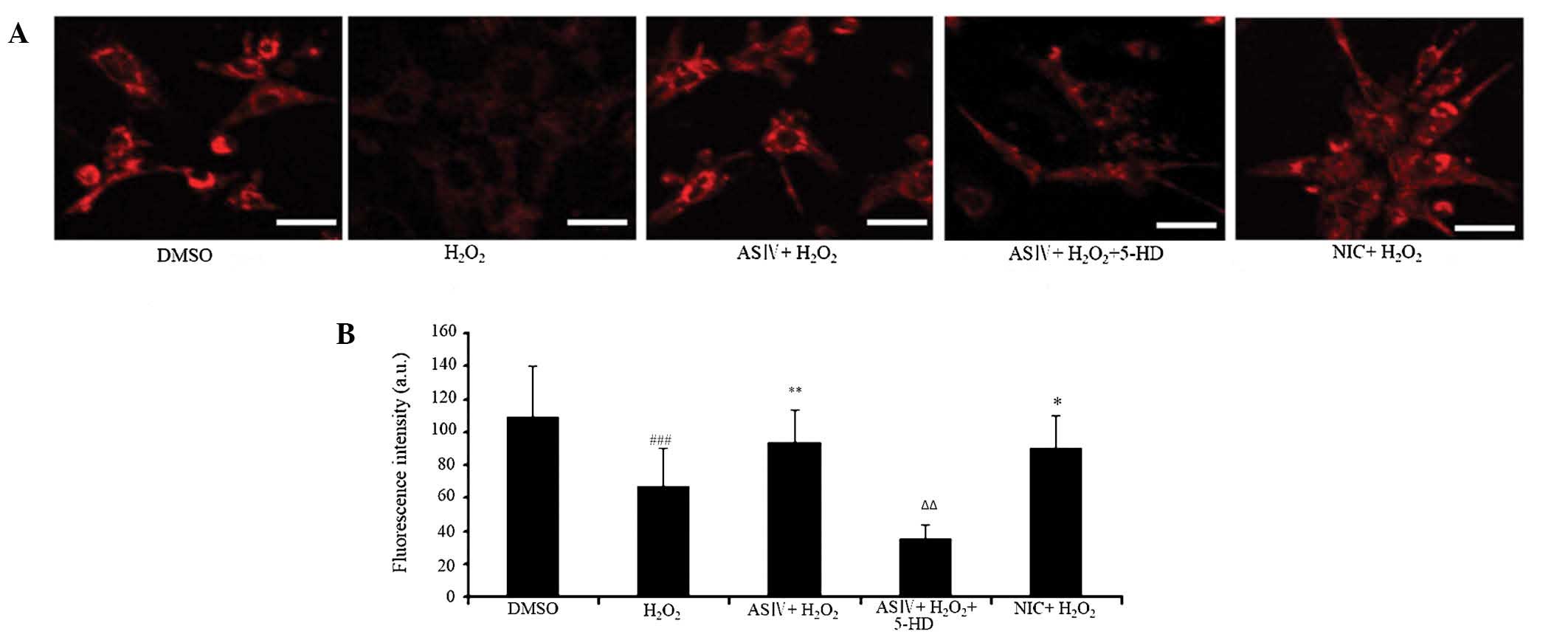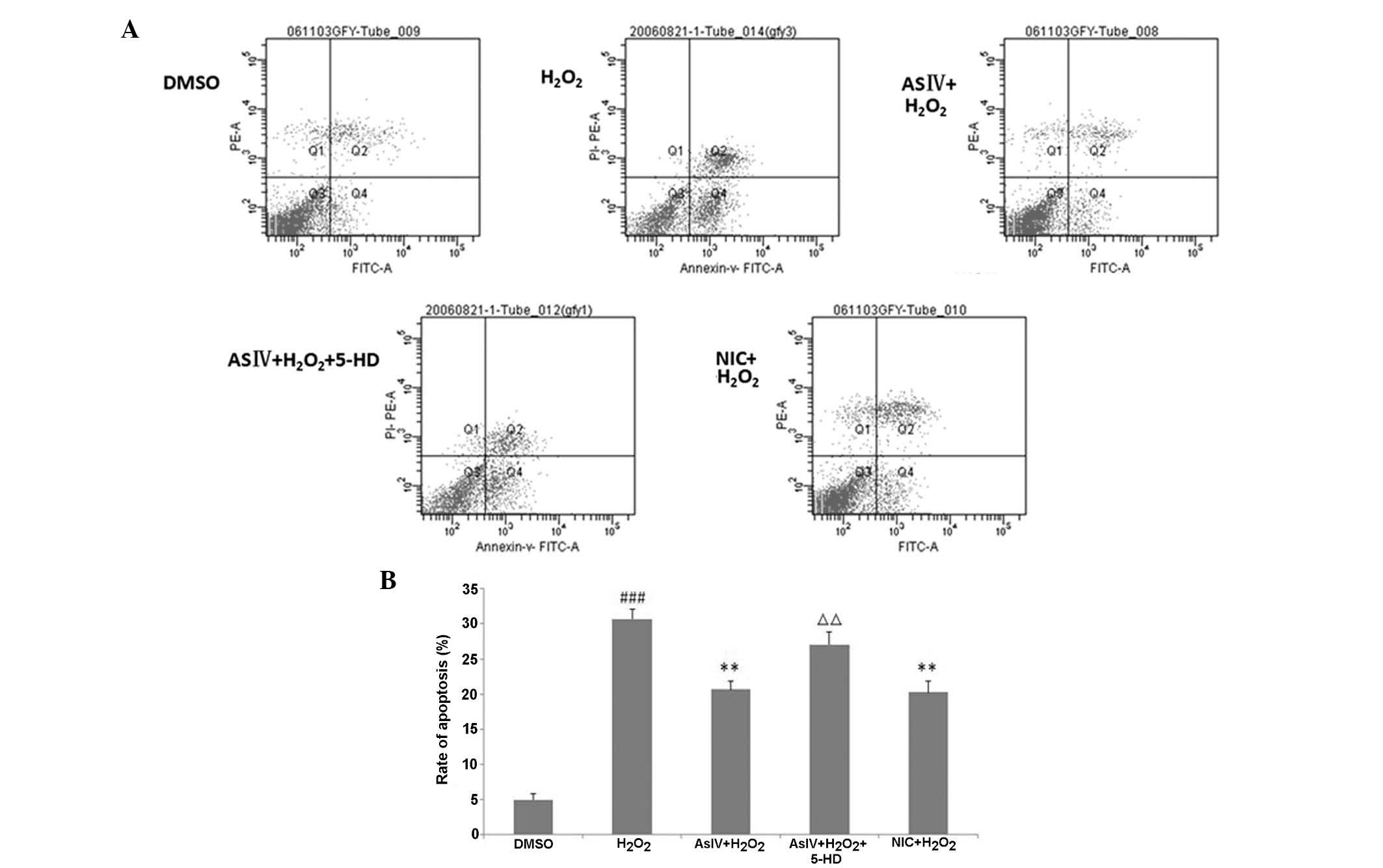Effect of astragaloside IV against rat myocardial cell apoptosis induced by oxidative stress via mitochondrial ATP-sensitive potassium channels
- Authors:
- Published online on: February 27, 2015 https://doi.org/10.3892/mmr.2015.3400
- Pages: 371-376
Abstract
Introduction
Reperfusion is the most effective method of limiting acute myocardial ischemia necrosis. However, reperfusion may also be associated with a burst of reactive oxygen species (ROS) production and intracellular calcium overload (1–3). These dichotic effects result in paradoxical cardiocyte dysfunction, a phenomenon termed myocardial ischemia reperfusion injury (MIRI). The role of mitochondria during MIRI is critical, as apoptosis is promoted by the mitochondrial pathway associated with the mitochondrial permeability transition (MPT). MPT pores (MPTPs) are located in the inner mitochondrial membrane, and when MIRI induces cellular dysfunction, including increased Ca2+ concentrations and oxidative stress, mitochondria undergo swelling and become uncoupled due to the opening of MPTPs (4). This leads to matrix swelling, release of apoptotic signaling molecules and irreversible injury to the mitochondria (5). The role of the mitoKATP channel in modulating cardiac mitochondrial function has been investigated previously (6,7). Wakiyama et al (8) confirmed that the opening of mitochondrial adenosine triphosphate-sensitive potassium channels (mitoKATPs) may reduce the release of cytochrome c, inhibit caspase-3 activation, stabilize the mitochondrial membrane potential (MMP) and inhibit apoptosis (8).
Astragaloside is one of the most common Traditional Chinese Medicines. It possesses multiple physiological and pharmacological functions, including a protective effect in the myocardium following ischemic injury. This effect may be associated with clearing oxygen free radicals or reducing blood viscosity (9,10). Notably, prior work has demonstrated that Astragalus injection (Huangqizhusheye) may activate the mitoKATPs and reduce MIRI (11). Astragaloside IV (AsIV) is an extract of the monomer astragaloside (Fig. 1). AsIV produces various effects, including protection against cerebral ischemia-reperfusion injury, and the attenuation of renal tubulointerstitial fibrosis and diabetes (12–14). Certain protective effects of AsIV on cardiovascular disease have also been suggested (15–19). In addition to providing cardioprotection during myocardial ischemia (18,19), AsIV has also been demonstrated to limit endothelial dysfunction induced by oxidative stress (15) and inhibit compensatory hypertrophy of myocardial cells (16). The results obtained in these previous studies provided the impetus to study the mechanism of AsIV protection during reperfusion.
In the current study, the protective role of mitoKATPs following AsIV treatment was investigated in cardiocytes. Oxidative stress in cardiocytes was stimulated by treating cultured cells with 0.2 mmol/l hydrogen peroxide (H2O2) (20), resulting in calcium overload and damage to the MMP. These three factors may act separately, or interact with each other to cause damage to cellular structure, function and metabolism, and ultimately result in cell death. This type of injury simulates the pathogenesis of MIRI; thus, the present study used this model to analyze the effect of AsIV on MIRI and its underlying mechanisms.
Materials and methods
Cell culture and reagents
Primary rat neonatal cardiocytes were derived from 1-2-day-old Wistar rats (Experimental Animal Holding Facility of Jilin University, China). Briefly, the hearts were removed under aseptic conditions and the ventricles were homogenized in D-Hank’s buffer. The tissue fragments were digested by stepwise exposure to 0.125% pancreatin (Gibco Life Technologies, Carlsbad, CA, USA). The dissociated cells were pre-plated for 90 min to remove fibroblasts, and the non-adherent cardiocytes were then plated at a density of 1×105 cells/mm2. Cells were cultured in Iscove’s modified Dulbecco’s medium supplemented with 10% fetal bovine serum and 1% penicillin/streptomycin (BHKT Clinical Reagent Co., Ltd, Beijing, China), and maintained at 37°C in an incubator with 95% O2 and 5% CO2. All animal studies were performed in accordance with the Guide for the Care and Use of Laboratory Animals and approved by the Institutional Animal Care and Use Committee of Jilin University (Changchun, China).
2,7-Dichlorofluorescein diacetate (DCFH), Fluo-3/AM, Rhodamine 123 and Annexin V were obtained from Sigma-Aldrich (St. Louis, MO, USA). The mitoKATP inhibitor 5-hydroxydecanoate (5-HD) was also obtained from Sigma-Aldrich.
Peroxidation injury
To induce oxidative stress, cells were cultured in serum-free medium for 12 h when the cells were semiconfluent and beating synchronously. For the peroxidation challenge, the cells were cultured in medium with 0.2 mmol/l H2O2 (Beijing Chemical Factory, Beijing, China) and maintained at 37°C for 24 h.
Experimental design
The present study utilized five experimental groups of cardiocytes as follows: i) The dimethyl sulfoxide (DMSO, Beijing Chemical Factory, Beijing, China) group, maintained in 0.1% DMSO; ii) the H2O2 group, treated with 0.2 mmol/l H2O2 for 24 h; iii) the AsIV+H2O2 group, pretreated with 30 mg/l AsIV (provided by Academy of Chinese Medical Sciences of Jilin Province, Changchun, China) for 30 min prior to H2O2 injury; iv) the AsIV+H2O2+5-HD group, pretreated with 50 μmol/l 5-HD for 5 min prior to the AsIV pretreatment; and v) the nicorandil (NIC; Changchun Dazheng International Trade Group Pharmaceutical Co., Ltd, Changchun, China)+H2O2 group, pretreated with 120 mg/l NIC for 30 min prior to H2O2 injury. The NIC+H2O2 group was used as a positive control. For all AsIV treatments, a 0.1% AsIV stock solution was dissolved in DMSO.
Cardiocyte viability and lactate dehydrogenase (LDH) activity
Cardiocyte survival was assessed using an MTT assay. Briefly, cells were incubated with 200 μl medium in 96-well plates, 5 μl MTT stock solution (5 mg/ml) was then added to each well and the cells were incubated for a further 4 h. Blue formazan precipitate was produced from the cells by adding 100 μl DMSO and gently shaking, and the absorbance was measured at 570 nm using an A-5082 ELISA reader (Chengdu Taimeng Technology Co., Ltd., Chengdu, China). LDH release was measured using a GF-200 Semi Automatic Biochemical Analyzer (Shandong Gaomi Caihong Instruments Co., Ltd., Gaomi, China).
Analysis of ROS production
Intracellular ROS levels were analyzed using a flow cytometer with DCFH staining. DCFH was dissolved in ethanol (Beijing Chemical Factory, Beijing, China) to produce a 1 mmol/l stock solution. Cells were subsequently washed three times with phosphate-buffered saline (PBS) prior to the addition of DCFH (10 μM). Following a 10-min incubation in the dark, the cells were washed three times then resuspended in PBS. Fluorescence was measured using a fluorescence microplate reader at 488/525 nm (Gemini XPS; Shanghai Spectrum Instruments Co., Ltd., Shanghai, China).
Apoptosis analysis
The non-adherent myocytes were digested by treatment with 0.25% pancreatin for 10 min. The cells were then washed twice with PBS, and the percentage of apoptotic cells was determined with an Coulter Epics XL flow cytometer (Beckman Coulter, Brea, CA, USA) after double staining with the Annexin V-FITC apoptosis detection kit (Tianjin Sungene Biotech Co., Ltd. China). Annexin V was used as an apoptosis indicator and propidium iodide (PI) as a necrosis indicator. An+PI− represents viable apoptotic cells in the lower right quadrant.
Cytosolic calcium concentration, [Ca2+]i
Fluo-3 was used as a Ca2+ indicator during fluorescence imaging to assess [Ca2+]i. Changes in [Ca2+]i were analyzed using a Fluoview FV500 confocal laser scanning microscope (Olympus Corporation, Tokyo, Japan). Cells in 24-well plates were washed with HEPES buffer and treated with Fluo-3/AM (10 μmol/l) for 40 min in the dark. Following removal of Fluo-3/AM, the cells were washed three times with HEPES, and fresh HEPES was added with the various drug treatments as described. Baseline fluorescence in normal cells was recorded for 1 min, then H2O2 was added and the change in fluorescence was measured for 5 min. The results were analyzed using software which accompanied the confocal microscope. Alterations in the levels of green fluorescence were used to evaluate [Ca2+]i.
MMP (ΔΨm)
Fluorescence imaging of ΔΨm was conducted using Rhodamine 123 as an indicator. Rhodamine 123 is a mitochondria-selective dye, which in a reaction driven by ΔΨm in normal polarized mitochondria, assembles into red fluorescence-emitting dimers forming J-aggregates. Changes in MMP were analyzed using the confocal microscope. Cells in 24-well plates were treated with Rhodamine 123 (5 μg/ml) for 10 min away from light. Following removal of Rhodamine 123, the cells were washed with PBS. The level of Rhodamine 123 was measured and analyzed with the Fluoview Viewer software, version 1.7a (Olympus Corporation).
Statistics
Data are expressed as the mean ± standard error of the mean. Statistical significance was calculated using one-way analysis of variance with Newman-Keuls post hoc test. P<0.05 was considered to indicate a statistically significant difference.
Results
Effect of AsIV on cardiocyte viability and the change in LDH activity
Pretreatment with AsIV significantly increased cardiocyte viability compared with that of the H2O2 group (P<0.05), while pretreatment with 5-HD resulted in reduced viability (P<0.05 vs. the AsIV group) (Fig. 2). As indicated in Fig. 3, cardiocyte damage resulting from H2O2 exposure was reflected by increased LDH release (P<0.01 vs. the DMSO control group); which was reduced by AsIV pretreatment (P<0.01 vs. the H2O2 group) and significantly increased in the 5-HD pretreatment group (P<0.05 vs. the AsIV group). These results indicated that AsIV may protect cardiocytes against H2O2 injury, while the mitoKATP inhibitor 5-HD may partially reverse this effect.
AsIV alters oxidative stress and [Ca2+]i
Elevated levels of ROS may contribute to ischemia-reperfusion injury. Therefore, the present study evaluated whether AsIV-mediated cardioprotection may be partially attributed to a reduction in oxidative stress. ROS generation was assessed by DCFH fluorescence. The results indicated that H2O2 induced significant ROS generation in cardiocytes compared with the DMSO control group (P<0.01) (Fig. 3), which was reduced following AsIV treatment (P<0.05 vs. the H2O2 group). This protective effect was significantly attenuated by 5-HD pretreatment (P<0.05). These results indicate that AsIV may protect cardiocytes against H2O2 injury by reducing oxidative stress; and this effect may be associated with the mitoKATP.
Ca2+ overload is a key contributor to the mitochondrial permeability transition leading to ischemia-reperfusion injury. As displayed in Fig. 4, AsIV-pretreated cells presented significantly lower [Ca2+]i compared with that of the H2O2 group (P<0.01). 5-HD pretreatment prior to AsIV exposure resulted in significantly higher [Ca2+]i compared with that of the AsIV group (P<0.01). These results indicated that AsIV may relieve Ca2+ overload, an effect which is also associated with the mitoKATP.
Changes in MMP
MPTP opening may be critical for the transition from reversible to irreversible myocardial ischemia-reperfusion injury. Therefore, the present study investigated MPTP dynamics in cardiocytes using Rhodamine 123. The MMP was (93.80±19.53) 30 min subsequent to AsIV treatment, which was significantly higher than that in the H2O2 group (P<0.01) (Fig. 5). 5-HD pretreatment prior to AsIV led to an MMP that was significantly lower than that of the AsIV group (P<0.01). These results demonstrated that AsIV may protect cardiocytes by stabilizing the MMP, and this effect may be associated with the mitoKATP.
Changes in the rate of apoptosis
The effect of AsIV on cell apoptosis was analyzed by measuring Annexin V positivity using flow cytometry. Pretreatment with AsIV led to significantly reduced Annexin V-positivity compared with the H2O2 group (P<0.01). By contrast, pretreatment with 5-HD resulted in a significant increase in the number of Annexin V-positive cells compared with the AsIV group (P<0.01) (Fig. 6). These results demonstrated that AsIV treatment may reduce apoptosis, and this may be associated with the mitoKATP.
Discussion
The generation of ROS leads to damage to the cellular membrane, and is able to evoke calcium overload by raising membrane permeability, resulting in an inflow of calcium ions. Calcium overload may activate calcium-dependent proteinase, which catalyzes the conversion of xanthine dehydrogenase to xanthine oxidase (XO). XO promotes xanthine decomposition into uric acid with concomitant excess oxygen free radical generation. Mitochondrial Ca2+ overload, coupled with a high intracytoplasmic ROS burden, promotes the opening of the MPTPs, which induces the release of calcium from mitochondria resulting in mitochondrial swelling or failure. The combination of increased ROS, Ca2+ overload and mitochondrial injury is a notable cause of cardiocyte apoptosis.
The results of the current study demonstrated that AsIV increased cardiocyte viability and reduced LDH release. Additionally, pretreatment with AsIV significantly reduced apoptosis, which demonstrated that AsIV was able to protect cardiocytes from H2O2 injury and inhibit apoptosis.
AsIV-mediated attenuation of ROS generation and Ca2+ overload in H2O2-damaged cardiocytes demonstrated that the protective effects of AsIV are dependent on antioxidant activity and reducing the intracellular calcium overload. These effects may protect cardiocytes by attenuating damage to mitochondrial function.
Mitochondrial activity is required for efficient function of the cardiovascular system. In response to cardiovascular injury, mitochondrial dysfunction may result in apoptosis and necrosis (21). A change in mitochondrial permeability is considered the primary event in the cell apoptosis cascade (22–24). The fluctuations in MMP result in cytochrome c release, which can initiate caspase-9 and -3 activation, and subsequent apoptosis (25). In the present study, AsIV was observed to protect against cell death by modulating mitochondrial membrane permeability, which may attenuate the release of cytochrome c and reduce cardiocyte apoptosis. MitoKATP channels are located in the mitochondrial inner membrane, and the opening of these channels has been suggested to be protective against excessive mitochondrial Ca2+ accumulation, as mitoKATP opening leads to depolarization, which reduces the driving force responsible for mitochondrial Ca2+ uptake (26). MitoKATP opening also regulates ROS generation; in early ischemia (30 min), mitoKATP opening can increase the production of ROS to begin cardiocyte protection by preconditioning. However, during late ischemia (24 h) or reperfusion, mitoKATP opening may reduce the production of ROS to reduce injury (27). Previous studies have indicated that mito-KATP serves an important function in the protection against ischemia-reperfusion injury by the mitoKATP opening agent, diazoxide, using an siRNA method and mitoKATP blocker 5-HD (28,29). Wakiyama et al (8) confirmed that mitoKATP opening may attenuate the release of cytochrome c, inhibit caspase-3 release, stabilize the MMP and inhibit apoptosis. Soeding et al (30) also demonstrated that levosimendan, a calcium sensitizer, preserves the contractile responsiveness of hypoxic human myocardium via mitoKATPs and potential pERK1/2 activation.
To investigate the link between AsIV and the mitoKATP, the present study examined the effect of 5-HD on the effects of AsIV. It was observed that pretreatment with 50 μmol/l 5-HD, (a specific mitoKATP blocker) partially abrogated the protective effect of AsIV in the cardiocytes. 5-HD led to a reduction in viability and MMP, an increase in the levels of LDH and apoptosis and an increase in calcium overload, compared with the AsIV group. These data indicate that AsIV may protect cardiocytes from H2O2 injury through activating mitoKATP. This concentration of 5-HD had no effect on cardiocytes alone (data not shown). It was also observed that AsIV produced a similar protective effect to the drug nicorandil, a mitoKATP activator.
Based on these findings, it was concluded that the opening of mitoKATPs may be the principal mechanism through which AsIV protects cardiocytes from H2O2 injury. AsIV may inhibit apoptosis in cardiocytes via several mechanisms: i) AsIV inhibits the initiation of apoptosis by reducing the formation of ROS and intracellular calcium overload; ii) AsIV inhibits the opening of MPTPs, which may reduce the release of apoptosis-inducing proteins, including cytochrome c, Smac and AIF; and iii) mitoKATP opening may facilitate the signal transduction required for protection by AsIV. Further studies are required to elucidate whether other trigger factors underlie the protective effects of AsIV. Additionally, the detailed downstream mediators of mitoKATP require clarification.
Acknowledgments
This study was supported by the Science and Technology Department of Jilin Province (grant no. YYZX201260).
References
|
Murphy E and Steenbergen C: Mechanisms underlying acute protection from cardiac ischemia-reperfusion injury. Physiol Rev. 88:581–609. 2008. View Article : Google Scholar : PubMed/NCBI | |
|
Paradies G, Petrosillo G, Pistolese M, Di Venosa N, Federici A and Ruggiero FM: Decrease in mitochondrial complex I activity in ischemic/reperfused rat heart: involvement of reactive oxygen species and cardiolipin. Circ Res. 94:53–59. 2004. View Article : Google Scholar | |
|
Lemasters JJ, Theruvath TP, Zhong Z and Nieminen AL: Mitochondrial calcium and the permeability transition in cell death. Biochim Biophys Acta. 1787:1395–1401. 2009. View Article : Google Scholar : PubMed/NCBI | |
|
Baines CP: The mitochondrial permeability transition pore and ischemia-reperfusion injury. Basic Res Cardiol. 104:181–188. 2009. View Article : Google Scholar : PubMed/NCBI | |
|
Weiss JN, Korge P, Honda HM and Ping P: Role of the mitochondrial permeability transition in myocardial disease. Circ Res. 93:292–301. 2003. View Article : Google Scholar : PubMed/NCBI | |
|
Fryer RM, Eells JT, Hsu AK, Henry MM and Gross GJ: Ischemic preconditioning in rats: role of mitochondrial K(ATP) channel in preservation of mitochondrial function. Am J Physiol Heart Circ Physiol. 278:H305–H312. 2000.PubMed/NCBI | |
|
Garlid KD and Halestrap AP: The mitochondrial K(ATP) channel-fact or fiction? J Mol Cell Cardiol. 52:578–583. 2012. View Article : Google Scholar : PubMed/NCBI | |
|
Wakiyama H, Cowan DB, Toyoda Y, Federman M, Levitsky S and McCully JD: Selective opening of mitochondrial ATP-sensitive potassium channels during surgically induced myocardial ischemia decreases necrosis and apoptosis. Eur J Cardiothorac Surg. 21:424–433. 2002. View Article : Google Scholar : PubMed/NCBI | |
|
Zhou JY, Fan Y, Kong JL, Wu DZ and Hu ZB: Effects of components isolated from Astragalus membranaceus Bunge on cardiac function injured by myocardial ischemia reperfusion in rats. Zhongguo Zhong Yao Za Zhi. 300–302. 2000.In Chinese. | |
|
Xu YC, Lan SL and Chen JY: Effects of huangqi sijun decoction on thyroxin and cyclic nucleotide levels in rat models with spleen deficiency syndrome. Chin Drug Res Clin Pharm. 18:291–293. 2007. | |
|
Guan FY and Yu XX: The protective effect of Astragalus membranaceus injection preconditioning on experimental myocardial ischemia/reperfusion injury in rats. Chin J Geront. 30:3126–3129. 2010. | |
|
Yang J, Li J, Lu J, Zhang Y, Zhu Z and Wan H: Synergistic protective effect of astragaloside IV-tetramethylpyrazine against cerebral ischemic-reperfusion injury induced by transient focal ischemia. J Ethnopharmacol. 140:64–72. 2012. View Article : Google Scholar | |
|
Meng LQ, Tang JW, Wang Y, et al: Astragaloside IV synergizes with ferulic acid to inhibit renal tubulointerstitial fibrosis in rats with obstructive nephropathy. Br J Pharmacol. 162:1805–1818. 2011. View Article : Google Scholar : PubMed/NCBI | |
|
Xie W and Du L: Diabetes is an inflammatory disease: evidence from traditional Chinese medicines. Diabetes Obes Metab. 13:289–301. 2011. View Article : Google Scholar : PubMed/NCBI | |
|
Qiu LH, Xie XJ and Zhang BQ: Astragaloside IV improves homocysteine-induced acute phase endothelial dysfunction via antioxidation. Biol Pharm Bull. 33:641–646. 2010. View Article : Google Scholar : PubMed/NCBI | |
|
Zhao Z, Wang W, Wang F, et al: Effects of Astragaloside IV on heart failure in rats. Chin Med. 4:62009. View Article : Google Scholar : PubMed/NCBI | |
|
Guan FY, Li H, Sun W and Yang SJ: Protective effects of Astragaloside IV on hydrogen peroxide-induced injury of cultured neonatal rat myocardial cells. J Jilin Uni Med Ed. 33:211–214. 2007. | |
|
Zhang WD, Chen H, Zhang C, Liu RH, Li HL and Chen HZ: Astragaloside IV from Astragalus membranaceus shows cardio-protection during myocardial ischemia in vivo and in vitro. Planta Med. 72:4–8. 2006. View Article : Google Scholar : PubMed/NCBI | |
|
Xu XL, Chen XJ, Ji H, et al: Astragaloside IV improved intracellular calcium handling in hypoxia-reoxygenated cardiocytes via the sarcoplasmic reticulum Ca-ATPase. Pharmacology. 81:325–332. 2008. View Article : Google Scholar | |
|
Yu WP, Xu GL, Shen CX and Qian ZY: Effects of crocetin on the apoptosis and the changes of its related regulating proteins caspase-3 and Bcl-2 induced by H2O2 in myocardial cell. Chin J Pathoph. 22:54–57. 2006. | |
|
Smith MA and Schnellmann RG: Calpains, mitochondria and apoptosis. Cardiovasc Res. 96:32–37. 2012. View Article : Google Scholar : PubMed/NCBI | |
|
Grivicich I, Regner A, da Rocha AB, et al: Irinotecan/5-fluorouracil combination induces alterations in mitochondrial membrane potential and caspases on colon cancer cell lines. Oncol Res. 15:385–392. 2005. | |
|
Kallio A, Zheng A, Dahllund J, Heiskanen KM and Harkonen P: Role of mitochondria in tamoxifen-induced rapid death of MCF-7 breast cancer cells. Apoptosis. 10:1395–1410. 2005. View Article : Google Scholar : PubMed/NCBI | |
|
Shrivastava A, Tiwari M, Sinha RA, et al: Molecular iodine induces caspase-independent apoptosis in human breast carcinoma cells involving the mitochondria-mediated pathway. J Biol Chem. 281:19762–19771. 2006. View Article : Google Scholar : PubMed/NCBI | |
|
Shi LG, Zhang GP and Jin HM: Inhibition of microvascular endothelial cell apoptosis by angiopoietin-1 and the involvement of cytochrome C. Chin Med J (Engl). 119:725–730. 2006. | |
|
Murata M, Akao M, O’Rourke B and Marban E: Mitochondrial ATP-sensitive potassium channels attenuate matrix Ca(2+) overload during simulated ischemia and reperfusion: possible mechanism of cardioprotection. Circ Res. 89:891–898. 2001. View Article : Google Scholar : PubMed/NCBI | |
|
Shahid M, Tauseef M, Sharma KK and Fahim M: Brief femoral artery ischaemia provides protection against myocardial ischaemia-reperfusion injury in rats: the possible mechanisms. Exp Physiol. 93:954–968. 2008. View Article : Google Scholar : PubMed/NCBI | |
|
Wu Q, Bie P, Tang C and Zhang YJ: An experiment study on the role of bcl-2 in attenuation ischemia-reperfusion injury in liver graft in mice induced by mitoKATP channel opener diazoxide. J Clin Med Practi. 12:35–40. 2008. | |
|
Tratsiakovich Y, Gonon AT, Krook A, et al: Arginase inhibition reduces infarct size via nitric oxide, protein kinase C epsilon and mitochondrial ATP-dependent K+ channels. Eur J Pharmacol. 712:16–21. 2013. View Article : Google Scholar : PubMed/NCBI | |
|
Soeding PF, Crack PJ, Wright CE, Angus JA and Royse CF: Levosimendan preserves the contractile responsiveness of hypoxic human myocardium via mitochondrial K(ATP) channel and potential pERK 1/2 activation. Eur J Pharmacol. 655:59–66. 2011. View Article : Google Scholar : PubMed/NCBI |



